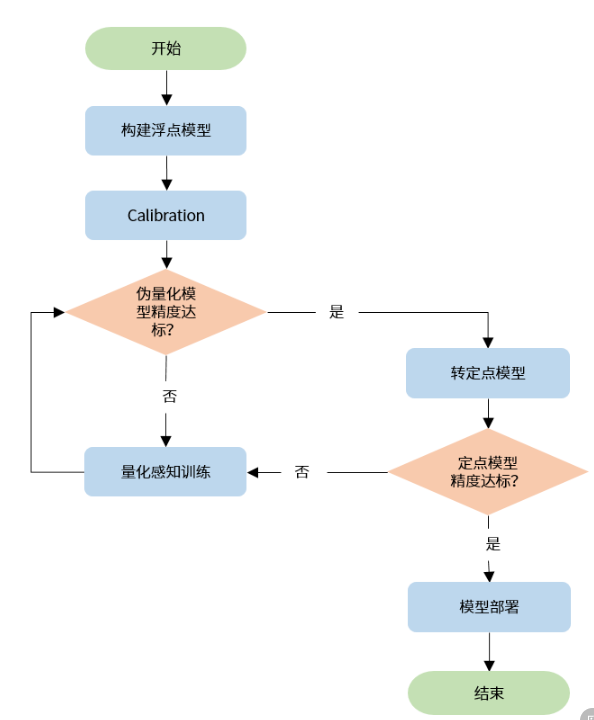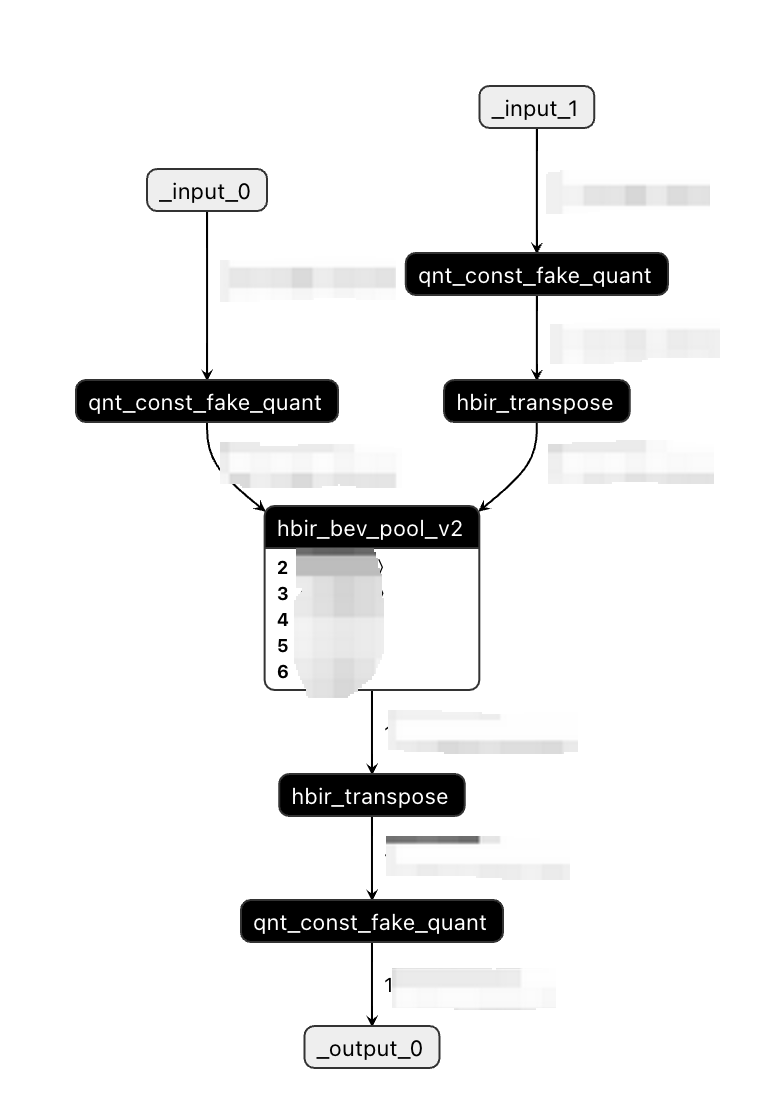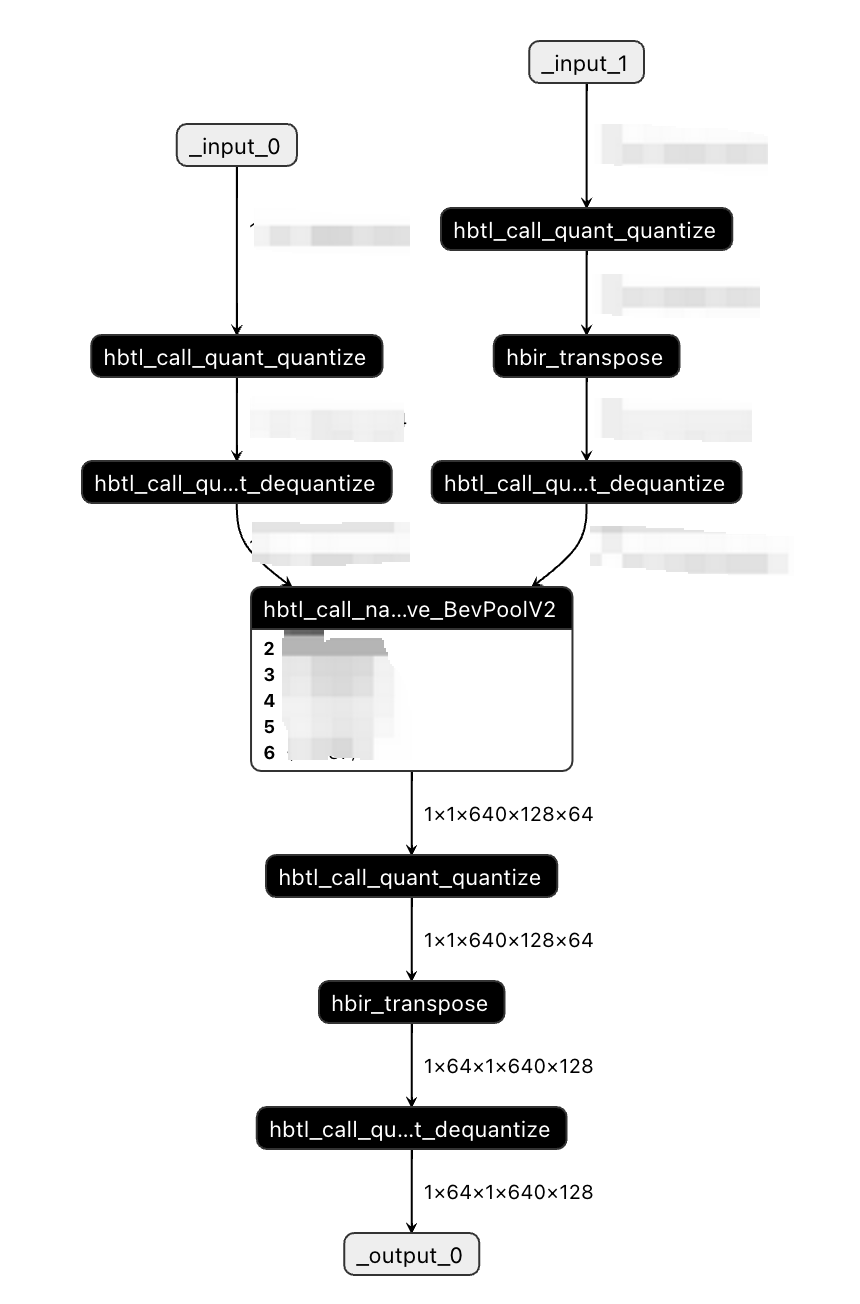征程 6 工具链 BEVPoolV2 算子使用教程 【2】-BEVPoolV2 QAT 链路实现示例
- 2025-03-10 广东
本文字数:4098 字
阅读完需:约 13 分钟

1.引言
在上一篇帖子中,我们已详尽阐述了 BEVPoolV2 相较于 BEVPoolV1 的改进之处,并对 BEVPoolV2 实现的代码进行了解析。想必大家对 BEVPoolV2 算子的功能及实现已有了一定程度的理解,此篇帖子将展示 征程 6 工具链 BEVPoolV2 单算子 QAT 链路的实现范例,以进一步增进用户对 BEVPoolV2 算子使用的认知。
2.QAT 代码实现
征程 6 工具链对齐 mmdet3d 的实现,目前已经支持了 BEVPoolV2 算子,QAT 链路中的核心函数如下:
def bev_pool_v2( depth: Tensor, feat: Tensor, ranks_depth: Tensor, ranks_feat: Tensor, ranks_bev: Tensor, interval_starts: Tensor, interval_lengths: Tensor, bev_feat_shape,): """BEVPoolv2 implementation for Lift-Splat-Shoot view transformation. This impl is same as following except the layout of inout feature: https://github.com/HuangJunJie2017/BEVDet/blob/dev3.0/mmdet3d/ops/bev_pool_v2/bev_pool.py Args: depth (Tensor[b, n, d, h, w]): Input depth. feat (Tensor[b, n, c, h, w]): Input features. ranks_depth (Tensor[n_points]): Depth index of points. ranks_feat (Tensor[n_points]): Feat index of points. ranks_bev (Tensor[n_points]): Output index of points. interval_starts (Tensor[n_pillars]): Starting position in ranks_xxx for each pooled point. # noqa: E501 interval_lengths (Tensor[n_pillars]): How many points in each pooled point. # noqa: E501 bev_feat_shape: Output shape in [b, z_out, h_out, w_out, c] or [z_out, h_out, w_out] or [h_out, w_out] format. When z_out is not given, its value will be 1 by default. Returns: Tensor[b, c, z_out, h_out, w_out]: Output features. """ if len(bev_feat_shape) not in (2, 3, 5): raise ValueError("Illegal bev_feat_shape length") if len(bev_feat_shape) < 5: bev_feat_shape = tuple(bev_feat_shape) if len(bev_feat_shape) == 2: bev_feat_shape = (1,) + bev_feat_shape b = feat.size(0) c = feat.size(2) bev_feat_shape = (b,) + tuple(bev_feat_shape) + (c,) if has_torch_function((depth, feat)): return handle_torch_function( bev_pool_v2, (depth, feat), depth, feat, ranks_depth, ranks_feat, ranks_bev, interval_starts, interval_lengths, bev_feat_shape, ) x = torch.ops.horizon.bev_pool_v2( depth, feat, ranks_depth, ranks_feat, ranks_bev, interval_starts, interval_lengths, bev_feat_shape, ) return x
docker 中代码路径: /usr/local/lib/python3.10/dist-packages/horizon_plugin_pytorch/nn/bev_pool_v2.py
详细说明 BEVPoolV2 算子在整个 QAT 链路使用流程
下面我们将以一个简单的单算子示例来详细说明 BEVPoolV2 算子在整个 QAT 链路使用流程。
首先,我们需要了解 QAT 链路的基本概念和工作原理,读者可以自行去学习 征程 6 工具链用户手册的快速上手章节。接下来,我们将详细介绍 BEVPoolV2 算子在 QAT 链路中的使用流程,涉及模型搭建、QAT 模型改造、模型导出与编译等。
本示例只为演示流程,未涉及到浮点训练和量化训练等流程。
3.输入准备
在进行 演示 QAT 链路之前,我们首先进行输入数据构建,这里要特别注意的是, BEVPoolV2 算子的性能和输入索引强相关,建议构建模型的时候使用真实输入。后面会结合代码进行说明。
4.示例代码
本示例代码基本遵循以下图中的 QAT 链路流程:

import copyimport torchimport torch.nn as nnimport numpy as npfrom horizon_plugin_pytorch.nn.bev_pool_v2 import BevPoolV2from horizon_plugin_pytorch.quantization.hbdk4 import exportfrom torch.quantization import DeQuantStubfrom horizon_plugin_pytorch.quantization import ( QuantStub, set_fake_quantize, FakeQuantState,)from horizon_plugin_pytorch.quantization.qconfig_template import default_calibration_qconfig_setterfrom horizon_plugin_pytorch.quantization.prepare import prepare, PrepareMethodfrom horizon_plugin_pytorch.march import March, set_marchfrom hbdk4.compiler import convert, compile, savedef load_input(b, d, h_out, w_out, c): #load 真实输入 #b:batch #d:depth数 #h_out, w_out:输出特征图大小 #c:通道数 depth = torch.Tensor(np.load("real_inputs/depth.npy")) feat = torch.Tensor(np.load("real_inputs/feat.npy")) ranks_depth = torch.Tensor(np.load("real_inputs/new_ranks_depth.npy")).type(torch.int32) # ranks_feat = torch.Tensor(np.load("real_inputs/new_ranks_feat.npy")).type(torch.int32) ranks_bev = torch.Tensor(np.load("real_inputs/new_ranks_bev.npy")).type(torch.int32) interval_starts = torch.Tensor(np.load("real_inputs/new_interval_starts.npy")).type(torch.int32) interval_lengths = torch.Tensor(np.load("real_inputs/new_interval_lengths.npy")).type(torch.int32) bev_feat_shape = (b, d, h_out, w_out, c) return depth, feat, ranks_depth, ranks_feat, ranks_bev, interval_starts, interval_lengths, bev_feat_shape#step1;构建复现浮点模型class SimpleBEVModel(nn.Module): def __init__(self,bev_feat_shape): super(SimpleBEVModel, self).__init__() self.bev_feat_shape = bev_feat_shape self.bev_pool = BevPoolV2(self.bev_feat_shape) self.quant1 = QuantStub() self.quant2 = QuantStub() self.dequant = DeQuantStub() _, _, self.ranks_depth, self.ranks_feat, self.ranks_bev, self.interval_starts, self.interval_lengths, _ = load_input(1, 1,640, 128, 64) def forward(self, data): depth = data["depth"] feat = data["feat"] #step2:改造模型 #在输入/输出分别插入QuantStub和DeQuantStub depth = self.quant1(depth) feat = self.quant2(feat) #调用BevPoolV2算子 bev_feat = self.bev_pool(depth, feat, self.ranks_depth, self.ranks_feat, self.ranks_bev, self.interval_starts, self.interval_lengths) print("output shape:",bev_feat.shape) bev_feat = self.dequant(bev_feat) return bev_featif name == '__main__':
b, d, h_out, w_out, c=1,1,640, 128, 64 depth, feat, ranks_depth, ranks_feat, ranks_bev, interval_starts, interval_lengths, bev_feat_shape = load_input( b, d, h_out, w_out, c ) print(f"Depth shape: {depth.shape} {depth.dtype}") print(f"Feat shape: {feat.shape} {feat.dtype}") print(f"Ranks depth shape: {ranks_depth.shape} {ranks_depth.dtype}") print(f"Ranks feat shape: {ranks_feat.shape} {ranks_feat.dtype}") print(f"Ranks bev shape: {ranks_bev.shape} {ranks_bev.dtype}") print(f"Interval starts shape: {interval_starts.shape} {interval_starts.dtype}") print(f"Interval lengths shape: {interval_lengths.shape} {interval_lengths.dtype}") print(f"BEV feat shape: {bev_feat_shape}")
model = SimpleBEVModel(bev_feat_shape) example_inputs = dict( depth=depth, feat=feat, ) import logging logging.basicConfig(filename='error.log', level=logging.ERROR) try: res_float = model(example_inputs) pass except Exception as e: logging.error("An error occurred: %s", e, exc_info=True) #配置march set_march(March.NASH_M) #step3:将浮点模型 prepare为伪量化模型 calib_model = prepare( copy.deepcopy(model), example_inputs=(example_inputs,), qconfig_setter=( default_calibration_qconfig_setter, ), method=PrepareMethod.JIT_STRIP, ) calib_model.eval() set_fake_quantize(calib_model, FakeQuantState.CALIBRATION) res_calib = calib_model(example_inputs) #step4:export出 qat.bc qat_hbir = export( calib_model, example_inputs, name="bevpool", ) save(qat_hbir,"bevpoolv2_qat.bc") #step5:将qat.bc convert为 quantized.bc quanti_hbir = convert(qat_hbir, "nash-e") save(quanti_hbir, "bevpoolv2_quantized.bc") compile( quanti_hbir, path="bevpoolv2.hbm", march='nash-e', opt=2, jobs=64, balance=100, progress_bar=True, )
运行此示例代码后,目录下会有 3 个文件生成:
bevpoolv2_qat.bc: 单算子伪量化 bc
bevpoolv2_quantized.bc:单算子定点 bc
bevpoolv2.hbm:上板部署的 hbm
5.模型可视化
获取以上模型后,可视化查看输入输出属性是否符合预期。
可视化方式可以使用 hb_model_info 命令行工具或者 visualize 接口来可视化 bc/hbm 模型。
bevpoolv2_qat.bc可视化:

bevpoolv2_quantized.bc可视化:

地平线开发者
还未添加个人签名 2021-03-11 加入
还未添加个人简介










评论